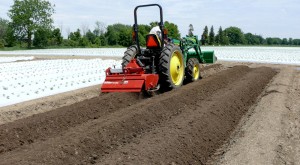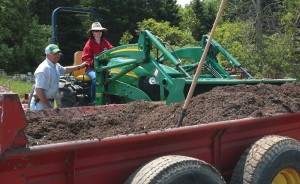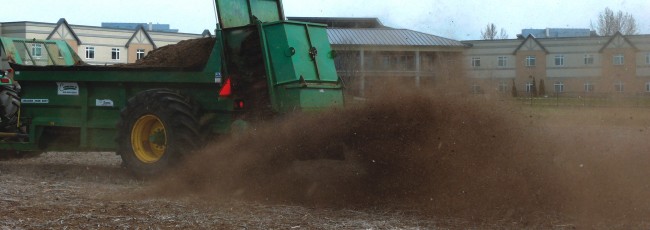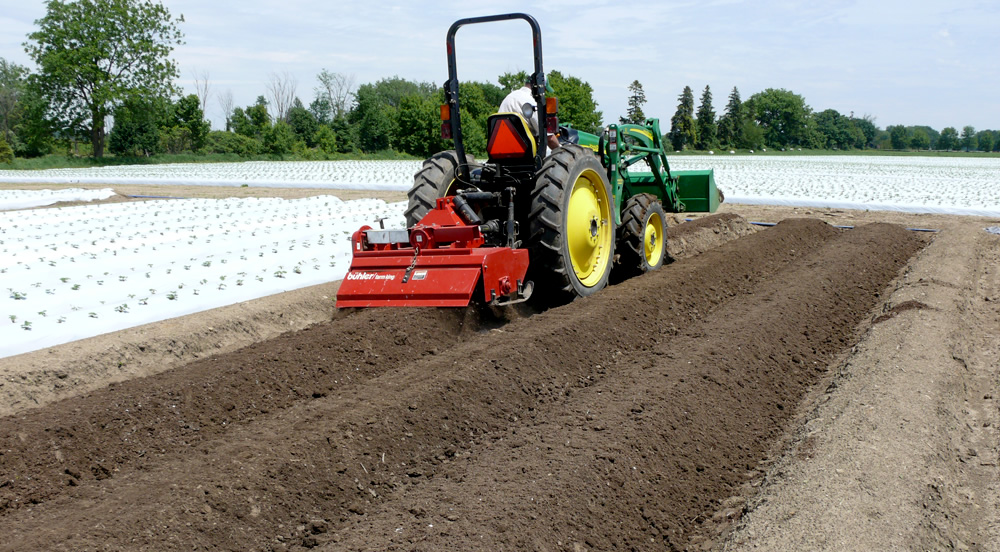Field trials are underway to determine whether compost made from source separated organics in the Toronto region improves soil quality and nutrient availability.
Peter Gorrie
BioCycle June 2013, Vol. 54, No. 6, p. 32

Compost was added to strawberry beds at Heeman’s Farm in London, Ontario in early June at rates of 2 tons/acre and 4 tons/acre. The compost was rototilled into the rows, which then were covered with plastic mulch and planted.
The study, to date funded by Ontario’s Ministry of Agriculture and Food and the Canadian Fertilizer Institute, began last year on corn and soybeans. Preliminary results indicate the compost, from source separated organics (SSO) collected through residential green bin programs across the province, led to a modest increase in productivity, although it’s too early to reach conclusions, says Brown, a nutrient management expert with OMAF.
While all compost producers in Ontario who work with municipally source separated organics support the trial, much of the material is being donated by Peel Region, a suburban and rural municipality, population 1.3 million, on the western border of Toronto, the province’s capital. The Region hopes to develop new uses as part of its endeavor to increase residential waste diversion to 70 percent by 2016, from the current 60 percent, says waste operations manager Larry Conrad.
Demand for compost from all markets exceeds the Region’s current annual output of nearly 17,000 tons, made from SSO mixed with leaves and yard trimmings. Most is now applied to residential or commercial gardens. Agriculture is also a viable market for compost produced from SSO, in part because that market can handle larger particle-sized material (up to 1.5 inches). “The material in the trials is coarser than the normal product,” explains Conrad, which makes it less desirable for domestic use or lawn care.

Compost from Orgaworld’s source separated organics composting facility in London, Ontario is being utilized in the strawberry crop trials at Heeman’s Farm.
Agriculture’s Perspective
On the other side, the provincial government is interested in improving soil health and resilience, and farmers are seeking a dependable source of organic nutrients that could replace several alternatives:
• Chemical fertilizers are expensive and don’t contribute organic matter’s microbes and moisture retention to soil.
• Biosolids from sewage treatment plants are transported and applied at no cost to farmers, but must be kept regulated distances from water, roads and homes. Processed into pellets, they’re sold as a commercial fertilizer with organic matter. But because they contain trace elements they can only be applied at a relatively low rate.
• Manure, the preferred organic amendment, is in short supply since there are fewer livestock farms in the province and farmers are less interested in selling it. “Crop producers are looking for a ‘manure’ source similar to their livestock farm neighbors’ material,” Brown says. “We’re trying to determine the benefits and the challenges.” In last year’s tests, soybean yields on composted fields increased by 0 to 7 bushels/acre, compared with the normal 35 to 45 bushels, and corn rose by 2 to 5 bushels, a small increase over the usual 150, she notes. But an abnormally dry early growing season reduced the impact of organic matter.
In all, up to 15 sites across the province are being evaluated in side-by-side comparisons. The application on alfalfa, at a farm about 50 miles northwest of Toronto, was the first to test a forage crop. High-value horticultural crops such as strawberries are also planned to be included in the application trials. “There’s huge potential” in that industry, Brown adds.
In early June, compost from Orgaworld’s SSO facility in London, Ontario was applied to research strawberry plots at Heeman’s Farm, located near London. This is the first application on strawberries in the Ontario trials. Plots are in 500-foot rows, and beds are 4-feet wide. One row received compost at a rate of 2 tons/acre, another at 4 tons/acre, and the rest are controls. The compost was shovelled on top of the rows by hand — less than five tons in total — then roto-tilled into the rows. The amended beds were covered in white plastic, and the ever-bearing strawberry plants were inserted through the plastic. Yield and plant growth, soil nutrients and soil organic matter conditions and other parameters will be monitored over the summer and for the next few seasons.

The compost utilized in the 3-year field trials being conducted by the Ontario Ministry of Agriculture and Food comes from residential green bin programs in Ontario, primarily from the Region of Peel. Up to 15 farm sites across the province are being evaluated in side-by-side comparisons with compost and controls.
Measuring The Impacts
The tests not only measure the impacts of different amounts of compost, but also how that material compares with chemical fertilizers and biosolids pellets. Fields are divided into plots, each with different nutrients applied or, as a control, none at all. The results also depend on initial soil health, weather conditions and farming practices. And one year of tests isn’t enough: “Improving soil organic matter is a long term process that works best in tandem with other management practices such as crop rotation, cover crops and crop residue management,” she explains.
There are also economic considerations to evaluate such as what the nutrient contribution is from compost and can that value cover the cost of buying, transporting and applying the material. Compost is less dense than fertilizer, which makes it more expensive to transport, Brown notes. As well, what application rate and frequency will improve organic matter levels in the soil? How are soil health improvements measured and what dollar value can be placed on soil resilience?
Bob Kerr, who rents the alfalfa land from semiretired farmer Bob Miesner, was operating one of the two spreaders applying compost to the field. The crop is to feed cattle on his home farm, he says. The land produced “almost nothing” last year. After hearing Brown speak at a conference, “I thought this (compost) could be an alternative to commercial fertilizer.”
The answers will start to arrive later this year.
Peter Gorrie is a Contributing Editor to BioCycle.










